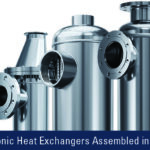Total System Efficiency with Condensing Boilers
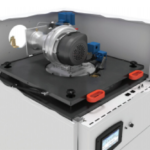 Boilers are closed pressure vessels that are used to heat fluids — either water or steam. They range in size, fluid to be heated, temperature of fluid and design configurations. This paper is the first in a series on Cleaver Brooks’ website to explain total system efficiency with a focus on condensing hot water boilers used for space heating, process applications and/or domestic hot water heating. In addition, this paper will describe how the design paradigm is shifting from non-condensing boilers with high-temperature, hot water distribution systems to condensing boilers with water temperatures as low as possible to increase boiler efficiency. The series of papers will take an incremental approach to total system design in order to address a variety of topics to increase building efficiency as our industry works towards the goal of net zero energy use in buildings.
Boilers are closed pressure vessels that are used to heat fluids — either water or steam. They range in size, fluid to be heated, temperature of fluid and design configurations. This paper is the first in a series on Cleaver Brooks’ website to explain total system efficiency with a focus on condensing hot water boilers used for space heating, process applications and/or domestic hot water heating. In addition, this paper will describe how the design paradigm is shifting from non-condensing boilers with high-temperature, hot water distribution systems to condensing boilers with water temperatures as low as possible to increase boiler efficiency. The series of papers will take an incremental approach to total system design in order to address a variety of topics to increase building efficiency as our industry works towards the goal of net zero energy use in buildings.
BOILER INTRODUCTION
In the past, the industry standard for hot water boilers was based on a non-condensing boiler where the hot water return temperature to the boiler had to stay above the condensing temperature of the flue gases to prevent damage to the boiler. Today, condensing boilers are becoming more popular with the intent of reducing the water temperature returning to the boiler to condense the flue gas as much as possible. There is a direct correlation between increasing condensation of the flue gas and boiler efficiency gains. Because of this, boiler construction for condensing boilers is different from non-condensing boilers. In condensing boilers, the heat exchanger has to be made of robust materials to prevent the acidic condensate from corroding and completely degrading the materials within the boiler and the flue stack. Condensing boiler heat exchangers are constructed of either stainless steel or aluminum construction as shown in Figures 1 & 2, which are more resistant to acid in the acidic condensate compared to non-condensing boilers that are made of cast iron, steel, or copper.
Figures 1 & 2: Condensing boiler materials of construction
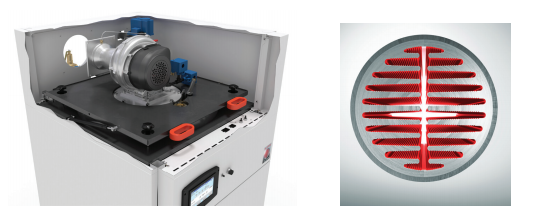
The majority of today’s hot water boilers utilize natural gas as a fuel source for the combustion process. In this process, natural gas is combined with combustion air to produce water and other by-products in the following chemical reaction:
CH4 + 2 O2 CO2 + 2 H2O
An alternative fuel is propane that has a similar combustion process to natural gas while also promoting condensing operation. In this process, propane is combined with combustion air to produce water and other by-products in the following chemical reaction:
C3H8 + 5 O2 3 CO2 + 4 H2O
In a non-condensing boiler, this water remains in a vapor state and is completely removed from the system in the flue gas, whereas in a condensing boiler, the water vapor is encouraged to condense as it is cooled below its dew point. The condensation of the flue gas enables the recovery of 970 btu/lb of latent energy, which is used to increase boiler efficiency. The dew point of the water varies based on many considerations, but generally speaking, flue gases begin to condense when the hot water return temperature is between 120°F to 130°F as shown in Figure 3.
Figure 3: Example of flue gas condensation temperature based on the hot water return temperature.
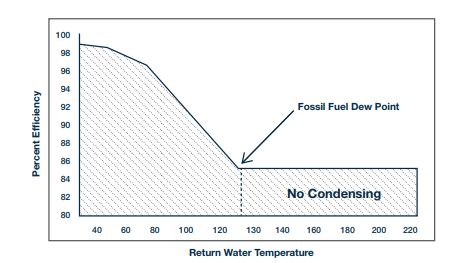
SYSTEM DESIGN
As boiler technology has evolved over time, so has system design. The first notable difference in system design relates to hot water supply and return temperatures. Previously, it was common to design systems with a hot water supply temperature in the range of 180°F to 200°F assuming that a higher water temperature was always better. To a point, a higher hot water temperature is better as it allows for smaller heat transfer surfaces in heating coils and terminal units, but it limits the efficiency of the system. Conversely, a higher hot water temperature can make it more difficult to control space temperature during periods of low loads when full capacity is not required by the building. Today, systems using condensing boilers should be designed with the lowest hot water supply and return temperature feasible while still adequately heating the space. It should be noted that hot water return temperature is the driving factor that dictates.
Figure 4: Boiler efficiency as a function of hot water return temperature and boiler firing rate.
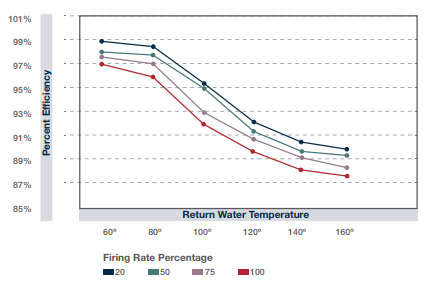
A standard hot water supply temperature for a condensing boiler should start at a minimum of 140°F with the ability to go lower, provided enough heating capacity is available at a reasonable cost from the heating coils and terminal units. Although a lower water temperature may be possible, there is a point where the increased first cost for additional heat transfer surface area exceeds the benefit of boiler efficiency. The hot water return temperature is a critical tipping point since a system that is not designed to have a hot water return temperature below the dew point of the flue gases will limit the potential benefits of a condensing boiler system. In this case, the boiler will not operate in condensing mode, and the energy savings will be much less than the system’s capability.
Relative to hot water system temperatures are system flow rates. Flow rates for older systems were typically designed for a temperature differential of 20°F between the hot water supply and return temperatures at the terminal units, which is above the condensing temperature and causes higher flow rates. Today, the temperature difference between the hot water supply and return temperatures should be between 30°F and 50°F, which decreases system flow rates, reduces pressure drops through heating coils and terminal units, and results in less system pumping power at full-load and part-load conditions. Because it is common to control the hot water system to the hot water supply temperature, a higher ΔT promotes a lower hot water return temperature to the boiler and leads to more condensing with increased boiler efficiency.
Another notable change in system design involves the system pumping configuration. Previously, hot water systems utilized a primary-secondary pumping configuration as the boilers were not designed for variable flow through the heat exchanger. This was a direct response to the ability to maintain the water temperature above the condensing point at low loads since these boilers were not designed for condensing applications. The result of the primary-secondary configuration is that constant flow through the boiler and heat exchanger was always maintained and the distribution system could accept variable flow based on the demand at the coils. Today, systems are shifting toward variable-primary flow systems with boilers designed to handle variable flow and condensing conditions. This results in multiple system benefits, including reduced first costs due to less system equipment, fewer electrical connections and a smaller overall footprint. From a first-cost standpoint, variable-primary flow will always be more economical due to less equipment, although the boiler first cost might be slightly more due to the need for high mass boilers capable of handling varying flow conditions. Using primary-only pumps also allows for larger, more efficient, base-mounted pumps in lieu of smaller, circulator-style pumps typical of primary pumps. Similarly, variable-primary flow through the boiler and terminal units enables reduced system flow rates at low loads, saving pumping energy while also increasing the available surface area in the condensing mode and allowing more time for the flue gases to be in contact with the heat exchanger.
Boiler flues should also be evaluated as condensing boilers have exhaust flue temperatures much lower than noncondensing boilers because the majority of the heat is removed from the flue gases during the condensing process. Condensing boilers also promote heat transfer with a larger heating surface area compared to traditional, non-condensing boilers. Consequently, the ability to use alternative materials for the exhaust stack is permissible, although it is highly recommended to use a UL Listed, Category IV venting material designed for use with condensing boilers. Although alternate stack materials are possible in certain instances, a corrosion-resistant stack material should be used for similar reasons as the boiler construction. Additionally, the exhaust stacks should be able to handle the high-temperature, exhaust flue gases that may exist if the boiler is ever operated in a non-condensing condition.
Finally, boiler mass is a consideration as systems should have the appropriate mass in the system to (1) accept changes in water temperature over time without excessive cycling, and (2) prevent thermal shock to the system. Boiler mass refers to the amount of water in the boiler heat exchanger. It directly correlates to the amount of time required for the water to heat up or cool down, which affects boiler cycling due to load changes, the ability to handle variable-flow conditions, and reduced system pressure drop. Low-mass boilers are defined as boilers with a water volume of less than 20 gallons per 1,000 MBH input, whereas high-mass boilers are defined as boilers with a water volume of greater than 50 gallons per 1,000 MBH. Today, some condensing boilers have considerably less mass than older, hot water boilers, and converting 4 from standard non-condensing, atmospheric boilers to high-efficiency, condensing, sealed combustion boilers must be thoroughly reviewed. A comparison of past systems to current systems is shown in Table 1.
Table 1: System design evolution over time.

BUILDING HEATING LOAD CALCULATIONS
In order to properly size the boiler system, the building heating load must be determined. The building heating system design is calculated based on a variety of loads that occur at various times within the building. Some of the loads include envelope-transmission losses, ventilation loads, infiltration loads, system losses, and pickup factors from night setbacks. Some loads such as people, lights, and miscellaneous loads as well as solar radiation are actual space loads, but are generally neglected or ignored in heating load calculations as these items are considered a benefit to the system and actually reduce the heating load required for the building. Taking into consideration that people are transient, lights can be turned on and off throughout the day, and equipment loads vary based on processing at any given time, these loads should not be assumed to be consistent. Similarly, solar radiation, due to the ever-changing position of the sun and weather conditions, can vary drastically throughout the day. It is common practice for designers and engineers to omit both of these loads or the credit from these loads as the interest is always in determining the worst-case design heating condition.
In addition to the heat gains that are not included in standard design calculations, designers and engineers also typically provide a safety factor on the load calculations ranging from 10% to 25% of the total building load. This leads to oversizing equipment that results in system inefficiency as the equipment will operate at different conditions than originally designed, which many times is far below a fully loaded condition. Couple this with the fact that the design load is based on an extreme weather condition that is rarely seen or only seen a couple hours a year, heating systems generally have sufficient built-in safety factors.
After loads are calculated, the next step in the design process is selecting heating coils and terminal units to satisfy the individual space loads. During equipment selection, actual heating capacity output will rarely match the calculated loads as most equipment is manufactured in modular capacities. As equipment is sized, it is selected at a capacity higher than the space load in order to maintain space conditions during a design condition, resulting in further oversized equipment.
For example, consider a building that has a heating load of 1,200 MBH. One option is to select one 1,500 MBH input boiler, which will cover the load, but will be oversized by approximately 12.5% assuming 90% efficiency. An alternative is to select three 500 MBH input boilers that achieve the same overall capacity but provide built-in redundancy with better staging and the ability to more closely match the varying load throughout the year. The boiler example can be extrapolated to the heating coils and terminal units throughout the building and generally speaking, the heating system is oversized compared to the amount of actual heat loss calculated in the initial step of the design process.
Based on all of the inherent design safety factors within a typical heating system, it is not necessary to include additional safety factors when selecting boiler equipment. Instead, it is best to provide a system diversity to approach a building load that is as accurate as possible with minimal oversizing. This should result in sizing equipment appropriately as system efficiency starts with load calculations and progresses into equipment selection and design applications. Oversized boilers also can lead to excessive cycling during shoulder seasons and low-load conditions. Boilers sized to meet the load requirements will run longer without cycling, which leads to less cycling and purge losses and greater boiler efficiency.
SYSTEM DESIGN & APPLICATIONS
Condensing boiler applications are widespread because of their many benefits and ease of incorporating them into a standard design. The best application for condensing boilers is within a system design that utilizes a low-temperature, hot water system; however, the benefits within traditional hot water system designs should not be overlooked. The following design options provide an introduction of how to include condensing boilers into traditional designs.
TRADITIONAL CONDENSING & NON-CONDENSING SYSTEMS
The traditional hot water system design includes a non-condensing boiler for space heating needs. The simplest solution for utilizing condensing technology is to substitute a condensing boiler in place of the standard, non-condensing boiler. Depending on the system temperatures, efficiency gains may be small because to achieve the highest efficiency, the system must operate in the condensing mode. Regardless of the boiler type, a condensing boiler will operate near the same efficiency point of a standard non-condensing boiler during conditions when the hot water return temperature is above the condensing temperature threshold. Despite this, in a standard system design it is still beneficial to operate condensing boilers given the ability to operate hot water reset strategies during periods of low-load or summer conditions, assuming that in the summer lower water temperatures can be used to meet the building loads. While a traditional, non-condensing boiler system would require a three-way mixing valve for supply temperature reset in order to protect the boiler, condensing boilers allow for a simpler system design since the supply temperature reset can occur (and is encouraged) at the boiler. During these conditions, careful consideration must be taken to avoid operating the hot water system at too high of a flow rate and trading boiler energy for pumping energy, but optimized appropriately, hot water reset can offer system efficiency gains.
HIGH ΔT SYSTEMS
Systems that operate with a high temperature differential between the hot water supply and return temperature are also candidates for condensing boiler systems since the hot water return temperature directly relates to boiler efficiency. An example of a high ΔT system would be designing at a typical hot water supply temperature of 180°F, but instead of using a 20°F temperature differential between the hot water supply and return temperatures, using a 30° to 50°F temperature differential. Although high-mass boilers are capable of handling higher ΔT’s without damaging the pressure vessel, the 30° to 50°F ΔT range offers the ideal mix of high ΔT and good operational control. As demonstrated below, system flow rate and ΔT are both factors in determining the total heat load based on the following heat transfer equation for water.
Q = 500 x GPM x ΔT Where: Q = Total heat load [BTU/H] GPM = Flow rate [GPM] ΔT = Supply and return piping temperature difference [°F]
By operating systems with high temperature differentials to serve the same heating load, pump energy can be saved by reducing the flow rates in addition to achieving reduced heating coil and terminal unit pressure drops. Since hot water systems are generally controlled to a hot water supply header setpoint, a larger ΔT will lead to lower return water temperatures and more operating hours in the condensing mode. This type of system also equates to overall distribution system cost savings due to smaller piping, smaller pumps, and smaller hydronic accessories throughout the system.
NON-TRADITIONAL SYSTEMS
Traditional hot water systems work well with condensing boilers as do several non-traditional systems. In general, any system that operates at a hot water return temperature below the condensing point is a perfect application. These options include: water-source heat pumps, in-floor hydronic radiant heating systems, snow-melt systems, domestic water heating, and pool heating systems. Each of these systems will be discussed in a future white paper. Boiler systems today are engineered to increase efficiency and reduce operating costs. Condensing boilers are a popular option because they recover energy that would otherwise be discharged out the boiler stack, enabling them to achieve 90%+ efficiency. Due to the industry’s move toward condensing boilers, there are differences that must be addressed in regard to hot water supply and return temperatures, boiler exhaust flue construction, pumping configurations, and system mass.
This paper is an introduction to total system efficiency for hot water heating systems. Subsequent papers will take a more in-depth look at system design and control strategies; advantages and disadvantages of this new design paradigm; myth-busting typical arguments designers, engineers, and owners have against condensing boiler systems; and retrofitting existing non-condensing boilers to condensing boilers. Condensing boilers can be incorporated into most systems where a standard boiler is used, but it is important to know the design modifications required to achieve system efficiency gains for a holistic solution.
Source: Cleaver Brooks

Written By: David Grassl | PE Mechanical Engineer | Principal



